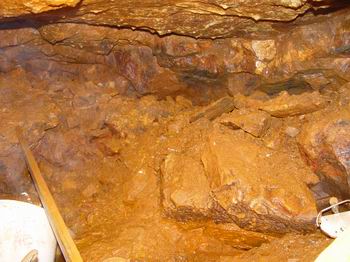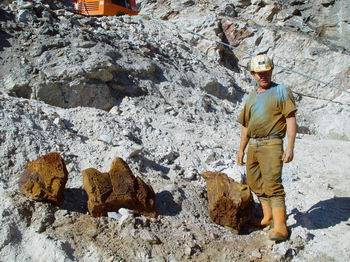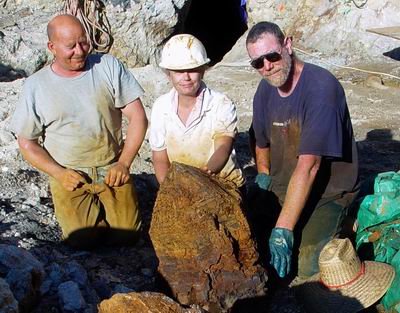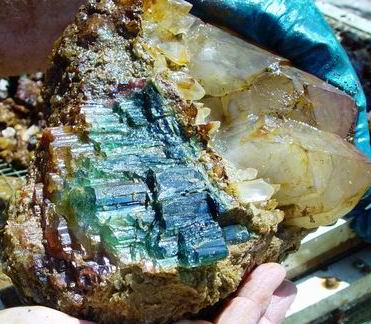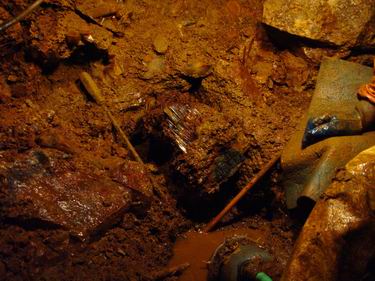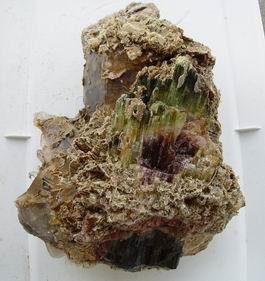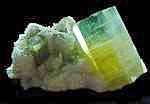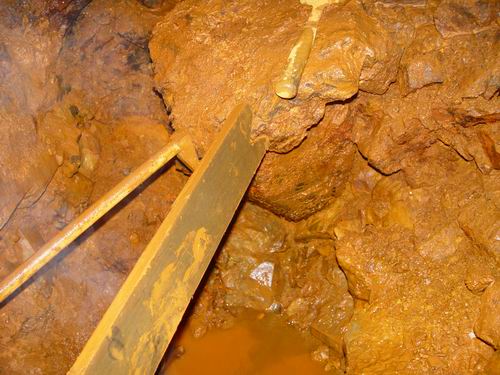
A huge quartz crystal in pocket MMP11-05 sits braced from falling
We could now see we had a major and muddy
task of pocket digging ahead of us. We knew from 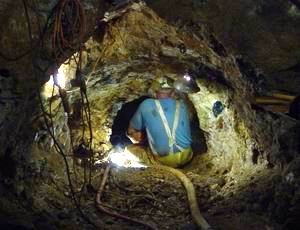 experience with
MMP28-04, that in the first few days of excavating the pocket we
would be removing only feldspar that had collapsed from the roof or a
few quartz crystals. Any major pieces, such as large tourmaline
crystals and beryls, would be deeper down in the pocket material. Only
in smaller pockets or satellite chambers would the 'good stuff' be
sitting right out in easy view. The outer camber of this pocket in fact
had bright pink tourmaline laying right on top. experience with
MMP28-04, that in the first few days of excavating the pocket we
would be removing only feldspar that had collapsed from the roof or a
few quartz crystals. Any major pieces, such as large tourmaline
crystals and beryls, would be deeper down in the pocket material. Only
in smaller pockets or satellite chambers would the 'good stuff' be
sitting right out in easy view. The outer camber of this pocket in fact
had bright pink tourmaline laying right on top. Before we could start digging in earnest our first order of business was to expand the small opening we had created into this immense pocket. Here Richard uses our chipping hammer to widen the entrance. Since starting underground, we have left the walls intact of the larger pockets we have found. We planned to do the same with this one. This is not efficient from a mining perspective but will leave a three dimensional record of the pockets and their locations. This is much better than hand waving a chunk of air and saying such and such pocket was found here. Although we hope the Mount Mica pegmatite will be productive for another 200 years, if it it isn't, perhaps the underground record will be. Our excavation plan called for removing sufficient material where we entered the pocket to enable us to work to the bottom. Once we found the bottom, we planned to keep it exposed as we expanded our excavated area. In this way we hoped to keep the material coming out better coordinated. If a piece dropped from the ceiling and broke, its fragments most likely would be arranged vertically.
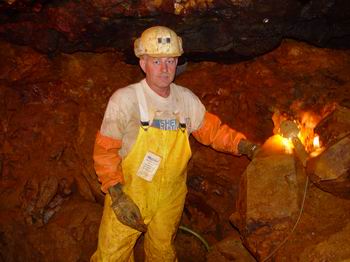 damage. This would be a challenge.
Although
we had not yet reached the bottom of the pocket, we were now several
feet below the entrance we had widened. The pocket had 'kettled'
dramatically in this chamber.[ Kettling is a term used by Frank Perham
to denote a drop in the garnet line in response to pocket development.
Normally the garnet line runs in a plane through the pegmatite
approximately mid way between the upper and lower contacts....very much
like the jelly in peanut butter and jelly sandwich. With the localized
concentration of minerals with a large pocket, this layer is displaced
lower in a bowl like fashion. I think of it simply as 5 Lbs of minerals
in a 3 Lb bag. ]
Initially we had begun digging the pocket laying down and dragging the
material into a 5 gallon bucket for screening. Within a few days
we were standing comfortably within the pocket and we still had not
reached the bottom. Here Richard stands in the front of the
central chamber with headroom to spare. To the right and left we had
not even begun to excavate. The large quartz to his left is resting
only in loose pocket material. Mary was anxious to come up and assist
with the digging. Her fear was the pocket would be cleaned out before
she arrived. To allay her concerns, we pledged only to dig
straight in and down. She need not have worried. damage. This would be a challenge.
Although
we had not yet reached the bottom of the pocket, we were now several
feet below the entrance we had widened. The pocket had 'kettled'
dramatically in this chamber.[ Kettling is a term used by Frank Perham
to denote a drop in the garnet line in response to pocket development.
Normally the garnet line runs in a plane through the pegmatite
approximately mid way between the upper and lower contacts....very much
like the jelly in peanut butter and jelly sandwich. With the localized
concentration of minerals with a large pocket, this layer is displaced
lower in a bowl like fashion. I think of it simply as 5 Lbs of minerals
in a 3 Lb bag. ]
Initially we had begun digging the pocket laying down and dragging the
material into a 5 gallon bucket for screening. Within a few days
we were standing comfortably within the pocket and we still had not
reached the bottom. Here Richard stands in the front of the
central chamber with headroom to spare. To the right and left we had
not even begun to excavate. The large quartz to his left is resting
only in loose pocket material. Mary was anxious to come up and assist
with the digging. Her fear was the pocket would be cleaned out before
she arrived. To allay her concerns, we pledged only to dig
straight in and down. She need not have worried.Finally with the aid of a winch and planking we were able to extricate the large crystal at the top of the page. It came out, amazingly enough, without causing any damage. There did not appear to have been any harm caused either when the crystal dislodged from the ceiling. Its point was pristine.
By the first of August and after a week and a half of digging the pocket, we were still working just at the entrance and we had still not reached the bottom. However, we were in deep enough that some better specimens began turning up. Other than small single crystals, the large tourmaline depicted above was the first large piece to come out. Shortly thereafter we found the tourmaline shown below.
The image of the tourmaline still in the pocket depicts just how chaotic the pocket contents were. Nothing like in the textbooks. The fracturing around the pockets at Mt. Mica seems to doom all of the large pockets to be completely 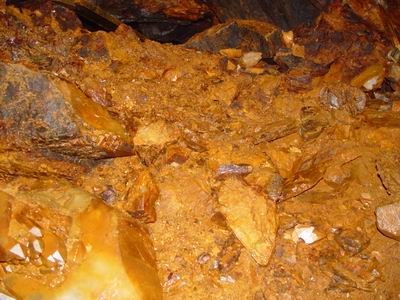 dominated by rust. As we toiled through
this mess, we fantasized how beautiful the pocket must have been near
the 'moment of creation' before entropy and ground water seepage began
to alter the landscape. dominated by rust. As we toiled through
this mess, we fantasized how beautiful the pocket must have been near
the 'moment of creation' before entropy and ground water seepage began
to alter the landscape. To our right the pocket material extended over our heads. There was also a long continuation in that direction that went somewhere. To the left there was a similar scene. It was clear there was lots of digging and screening ahead of us still. |
||||||
| Go
to July/August : Page 1, 2, 4 |
